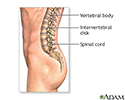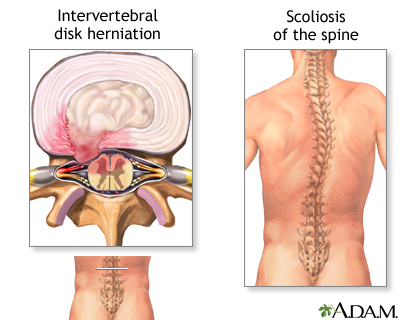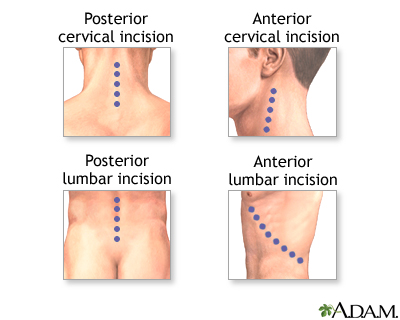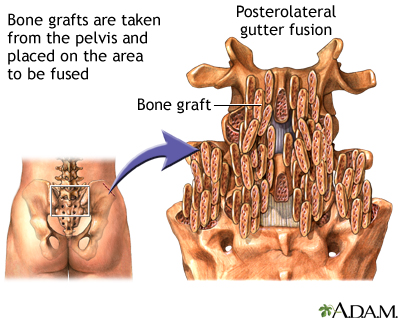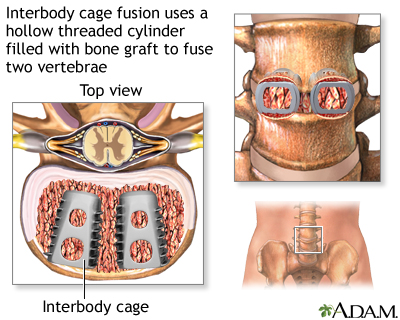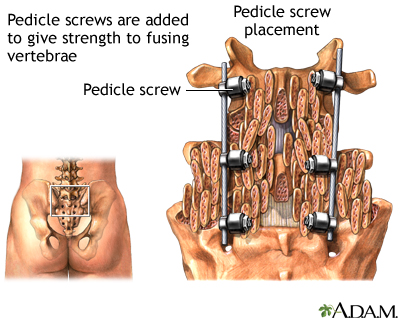Spinal fusion
Vertebral interbody fusion; Posterior spinal fusion; Arthrodesis; Anterior spinal fusion; Spine surgery - spinal fusion; Low back pain - fusion; Herniated disk - fusion; Spinal stenosis - fusion; Laminectomy - fusion
Spinal fusion is surgery to permanently join together two or more bones in the spine so there is no movement between them. These bones are called vertebrae.
Description
You will be asleep and feel no pain (general anesthesia).
The doctor will make a surgical cut (incision) to view the spine. Other surgery, such as a diskectomy , laminectomy , or a foraminotomy , is almost always done first. Spinal fusion may be done:
Diskectomy
Diskectomy is surgery to remove all or part of the cushion that helps support part of your spinal column. These cushions are called disks, and they ...

Laminectomy
Laminectomy is surgery to remove the lamina. This is part of the bone that makes up a vertebra in the spine. Laminectomy may also be done to remove...
Foraminotomy
Foraminotomy is surgery that widens the opening in your back where nerve roots leave your spinal canal. You may have a narrowing of the nerve openin...
- On your back or neck over the spine. You may be lying face down. Muscles and tissue will be separated to expose the spine.
- On your side, if you are having surgery on your lower back. The surgeon will use tools called retractors to gently separate, hold the soft tissues and blood vessels apart, and have room to work.
- With a cut on the front of the neck, toward the side.
The surgeon will use a graft (such as bone) to hold (or fuse) the bones together permanently. There are several ways of fusing vertebrae together:
-
Strips of
bone graft material
may be placed over the back part of the spine.
Bone graft material
A bone graft is surgery to place new bone or bone substitutes into spaces around a broken bone or bone defects.
 ImageRead Article Now Book Mark Article
ImageRead Article Now Book Mark Article - Bone graft material may be placed between the vertebrae.
- Special cages may be placed between the vertebrae. These cages are packed with bone graft material.
The surgeon may get the bone graft from different places:
- From another part of your body (usually around your pelvic bone). This is called an autograft. Your surgeon will make a small cut over your hip and remove some bone from the back of the rim of the pelvis.
- From a bone bank. This is called an allograft.
- A synthetic bone substitute can also be used.
The vertebrae may also fixed together with rods, screws, plates, or cages. They are used to keep the vertebrae from moving until the bone grafts are fully healed.
Surgery can take 3 to 4 hours.
Why the Procedure Is Performed
Spinal fusion is most often done along with other surgical procedures of the spine. It may be done:
-
With other surgical procedures for
spinal stenosis
, such as foraminotomy or laminectomy
Spinal stenosis
Spinal stenosis is narrowing of the spinal column that causes pressure on the spinal cord, or narrowing of the openings (called neural foramina) wher...
 ImageRead Article Now Book Mark Article
ImageRead Article Now Book Mark Article - After diskectomy in the neck
Spinal fusion may be done if you have:
- Injury or fractures to the bones in the spine
- Weak or unstable spine caused by infections or tumors
-
Spondylolisthesis
, a condition in which one vertebrae slips forward on top of another
Spondylolisthesis
Spondylolisthesis is a condition in which a bone (vertebra) in the spine moves forward out of the proper position onto the bone below it.
Read Article Now Book Mark Article -
Abnormal curvatures, such as those from
scoliosis
or
kyphosis
Scoliosis
Scoliosis is an abnormal curving of the spine. Your spine is your backbone. It runs straight down your back. Everyone's spine naturally curves a b...
 ImageRead Article Now Book Mark Article
ImageRead Article Now Book Mark ArticleKyphosis
Kyphosis is a curving of the spine that causes a bowing or rounding of the back. This leads to a hunchback or slouching posture.
 ImageRead Article Now Book Mark Article
ImageRead Article Now Book Mark Article - Arthritis in the spine, such as spinal stenosis
You and your doctor can decide when you need to have surgery.
Risks
Risks for anesthesia and surgery in general include:
-
Reactions to medicines,
breathing problems
Breathing problems
Breathing difficulty may involve:Difficult breathingUncomfortable breathingFeeling like you are not getting enough air
 ImageRead Article Now Book Mark Article
ImageRead Article Now Book Mark Article -
Bleeding,
blood clots
, infection
Blood clots
Blood clots are clumps that occur when blood hardens from a liquid to a solid. A blood clot that forms inside one of your veins or arteries is calle...
 ImageRead Article Now Book Mark Article
ImageRead Article Now Book Mark Article
Risks for this surgery include:
- Infection in the wound or vertebral bones
- Damage to a spinal nerve, causing weakness, pain, loss of sensation, problems with your bowels or bladder
- The vertebrae above and below the fusion are more likely to wear away, leading to more problems later
Before the Procedure
Tell your doctor or nurse what medicines you are taking. These include medicines, herbs, and supplements you bought without a prescription.
During the days before the surgery:
- Prepare your home for when you leave the hospital.
-
If you are a smoker, you need to
stop
. People who have spinal fusion and continue to smoke may not heal as well. Ask your doctor or nurse for help.
Stop
Surgery - quitting smoking; Surgery - quitting tobacco; Wound healing - smoking
Read Article Now Book Mark Article - Two weeks before surgery, your doctor or nurse may ask you to stop taking medicines that make it harder for your blood to clot. These include aspirin, ibuprofen (Advil, Motrin), naproxen (Aleve, Naprosyn), and other drugs like these.
-
If you have
diabetes
, heart disease, or other medical problems, your surgeon will ask you to see your regular doctor.
Diabetes
Diabetes is a chronic disease in which the body cannot regulate the amount of sugar in the blood.
 ImageRead Article Now Book Mark Article
ImageRead Article Now Book Mark Article - Talk with your doctor if you have been drinking a lot of alcohol.
- Ask your doctor which medicines you should still take on the day of the surgery.
- Let your surgeon know about any cold, flu, fever, herpes breakout, or other illnesses you may have.
On the day of the surgery:
- Follow instructions about not drinking or eating anything before the procedure.
- Take the medicines your doctor told you to take with a small sip of water.
- Arrive at the hospital on time.
After the Procedure
You will stay in the hospital for 3 to 4 days after surgery.
You will receive pain medicines in the hospital. You may take pain medicine by mouth or have a shot or an intravenous line (IV). You may have a pump that allows you to control how much pain medicine you get.
You will be taught how to move properly and how to sit, stand, and walk. You will be told to use a "log-rolling" technique when getting out of bed. This means that you move your entire body at once, without twisting your spine.
You may not be able to eat for 2 to 3 days. You will be given nutrients through an IV. When you leave the hospital, you may need to wear a back brace or cast.
Your health care provider will tell you how to take care of yourself at home after spine surgery . Follow instructions on how to take care of your back at home .
Take care of yourself at home after spi...
You were in the hospital for spine surgery. You probably had a problem with one or more disk, a cushion that separates the bones in your spine (vert...

Take care of your back at home
Low back pain refers to pain that you feel in your lower back. You may also have back stiffness, decreased movement of the lower back, and difficult...

Outlook (Prognosis)
If you had chronic back pain before surgery, you will likely still have some pain afterward. Spinal fusion is unlikely to take away all your pain and other symptoms.
Chronic back pain
Low back pain refers to pain that you feel in your lower back. You may also have back stiffness, decreased movement of the lower back, and difficult...

It is hard for a surgeon to predict which patients will improve and how much relief surgery will provide, even when using MRI scans or other tests.
Losing weight and getting exercise increases your chances of feeling better.
Future spine problems are possible after spine surgery. After spinal fusion, the area that was fused together can no longer move. Therefore, the spinal column above and below the fusion are more likely to be stressed when the spine moves, and may have problems later on.
References
Liu G, Wong HK. Laminectomy and fusion. In: Shen FH, Samartzis D, Fessler RG, eds. Textbook of the Cervical Spine . Philadelphia, PA: Elsevier Saunders; 2015:chap 34.
Wood GW. Arthrodesis of the spine. In: Canale ST, Beaty JH, eds. Campbell's Operative Orthopaedics . 12th ed. Philadelphia, PA: Elsevier Mosby; 2013:chap 39.
-
Scoliosis - illustration
Abnormal curvature in the spine is known as scoliosis, and generally begins just at the onset of puberty and progresses during the period of rapid growth. Most junior high schools routinely screen for scoliosis because, if caught early, progressive spine curvature can be prevented. Scoliosis affects girls much more frequently than boys.
Scoliosis
illustration
-
Spinal fusion - series
Presentation
-
Scoliosis - illustration
Abnormal curvature in the spine is known as scoliosis, and generally begins just at the onset of puberty and progresses during the period of rapid growth. Most junior high schools routinely screen for scoliosis because, if caught early, progressive spine curvature can be prevented. Scoliosis affects girls much more frequently than boys.
Scoliosis
illustration
-
Spinal fusion - series
Presentation
Review Date: 9/22/2016
Reviewed By: C. Benjamin Ma, MD, Assistant Professor, Chief, Sports Medicine and Shoulder Service, UCSF Department of Orthopaedic Surgery, San Francisco, CA. Also reviewed by David Zieve, MD, MHA, Isla Ogilvie, PhD, and the A.D.A.M. Editorial team


